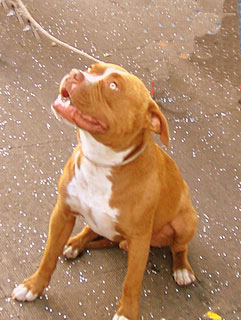
Should they be banned or not?
During a recent drug bust carried out by the police in Santiago, the Chilean capital, a large deposit of cocaine was discovered hidden a in house's sewer tank. However, the only problem faced by the police was that sitting on top of the tank's cover was an "Argentine Dogo", one of the most fiercest guard dogs in the world. The traffickers had left the dog there to guard the illegal drugs, and they could not have thought of a better specimen for the task. The police were able to control the "Dogo" thanks to its specialized K-9 unit and without harming the animal.
Due to the many cases of burglaries, many Chilean families have decided to adopt these dogs in order to guard their property. Unfortunately, there have been many incidents where innocent people and children have been killed or badly maimed by attack dogs such as the Dogo, Pitbull and Rottweiler. In 2005 there was a debate in the Chilean congress to pass a law that would impose tougher controls on these breeds of attack dogs. Along with the Brazilian "Fila", the "Dogo" is a South American breed that was the product of intensive breeding with imported dogs. In 1925, two Argentine brothers, Antonio and Agustin Nores set upon creating a breed of dog that would be both a brave hunter and a loyal companion to its owners.
Pitbull

 Brazilian Fila
Brazilian FilaThey began with a local breed called "Cordoba Fighting Dog" and bred it with a Pointer to get a dog with good smelling senses. The Boxer was used to make its temper slightly more sociable, the Great Dane to get height (63.5 cm /25 inches in males and 59.7 cm /23.5 inches in females) and the Bulldog to get a balanced body structure. The Bull Terrier was used during the initial breeding to add bravery, the Irish Woolhound increased the height and hunting instinct and the Pyrinees Mountain Dog provided the traditional white fur. Finally the Spanish Mastiff was added to secure that the dog would have a large size (weight of between 36 to 45 Kilograms (80 to 100 pounds).
During its first trials, the Dogo proved to be not only a very good hunting dog but also a reliable guardian. Another peculiar characteristic of this breed is that it has small ears and also it is common for owners to cut them to give the Dogo the appearance similar to a fighting dog such as the "Pitbull". The Dogo has a good character with the owner and also with the family's children. However, the breeding process did have one flaw: at least 10% of the Dogos are born with deafness, it is recommended that before adopting the dog must be checked that it hears properly.
The Brazilian "Fila" is taller than the Dogo (between 65 to 70 cm/25.6 to 27.6 inches in males and 60 cm/23.6 inches in females) and differs in the color since it can never be white, always dark grey or a tigrish color. "Faithful like a Fila" is a well-known Brazilian proverb, this dog is always looking after its owner and is very gentle with the children of the house. On the other hand, the Fila´s main trait is the mistrust towards strangers and during exhibition shows the judges must never touch a Fila, otherwise they will suffer the consequences! The ancestors of this dog are the "Fila Terceirense", a race brought in from Portugal at the beginning of the sixteenth century. The Terceirense was a guardian of cattle and soon the Portuguese began to breed it with other races in order to adapt the dog to the tropical climate of Brazil. The Fila also inherited the characteristics of the Bulldog or Doggen Engelsen ( very aggressive and stubborn character ), English mastiff (strength and lockjaw bite) and the Bloodhound (good at tracking and a higher pitch bark when angry). Soon the Fila proved to be extremely efficient in the tracking down of runaway prisoners and slaves and to guard large herds of cattle.
In recent years the Brazilian Army has used the Fila during operations in the dense Amazon jungle. The Army also carried out a five year experiment to compare the Fila´s performance against that of the Doberman and German Sheperd. This experiment concluded that the Fila was the most suitable dog to perform under hostile jungle conditions. Currently the Fila is used by the K-9 unit of the U.S police and as a guard dog in countries such as Israel and Nigeria.















No comments:
Post a Comment